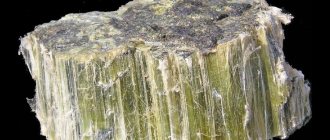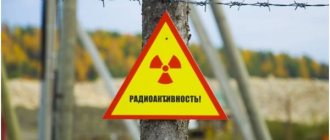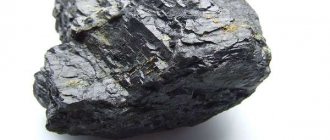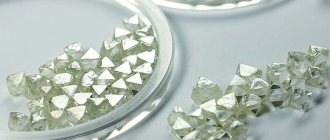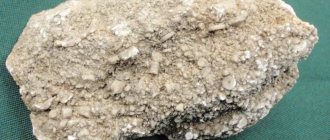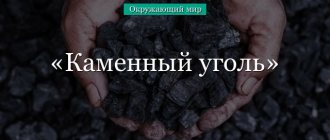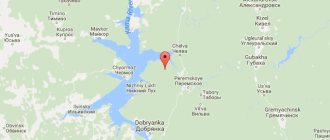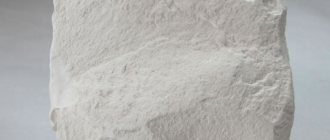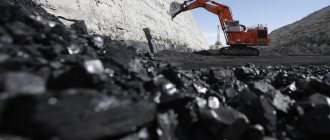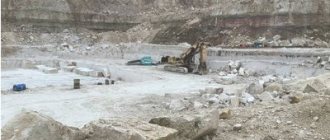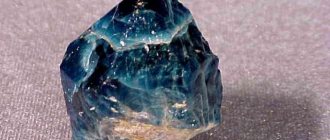Limestone is a sedimentary rock that is composed primarily of calcium carbonate (formula: CaCO3). Its bulk is the result of deposits of hard shells and shells of ancient marine organisms. Less common is limestone formed by chemical means.
Due to the presence of acids in water, this rock tends to gradually dissolve, which leads to the appearance of caves and karst cavities. When heated, it decomposes, releasing carbon dioxide. This reaction is used in the production of cement and is also responsible for the presence of gas in mineral waters.
Description
The basis of limestone is calcium carbonate, a substance that can dissolve in water. As a result, karst is formed. It can decompose into bases and carbon dioxide. This is carried out at great depths, because due to the influence of the Earth’s heat, limestone forms gas for mineral waters.
Limestone may include admixtures of clay minerals, dolomite, quartz, gypsum, and pyrite. Natural limestone is light gray in color, although it can be black or white. Impurities give a blue, pink, yellow tint. Limestone mining is in demand due to its widespread use. The breed is durable and known for its unique characteristics that make it unlike other materials.
Classification
A common type of rock is shell rock, which consists of shells of marine animals and their fragments. There are other types of limestone:
- Bryozoan, which includes the remains of bryozoans - small invertebrate animals that live in colonies in the seas.
- Nummulite, consisting of extinct single-celled nummulite organisms.
- Marbled. It can be thin-layered or massively layered.
During metamorphism, a process of recrystallization occurs with limestone, due to which this rock forms marble.
Limestone is considered a monomineral rock, the method of extraction of which may differ depending on the type of impurities, structure, and geological age. There are organizations that are engaged in extracting limestone. Places and methods of extraction are determined by terrain, types of rocks and other characteristics.
What is limestone
Limestone is a mineral. It comes in light or dark color. Structure with fine or large grains.
The stone is formed over centuries at the bottom of reservoirs from sedimentary rock. It is found in the locations of ancient and modern oceans and seas.
In addition to calcium, natural stone also contains:
- sea lilies, urchins;
- corals;
- shells;
- shellfish;
- brachiopods;
- foraminifera;
- crinoids;
- fossilized fish skeletons.
The basis of the chemical composition is 50–95% calcium carbonate. The density of the mineral and the purity of its white color depend on the concentration of calcite. The stone also contains 5-50% quartz, feldspars, opal, dolomite, chalcedony or kaolin (clay). They color the mineral grey, pink, red, cream, black or blue.
Varieties and colors
According to application, limestone is divided into feed, flux, and construction limestone. The first is small, cleared of impurities, used for mineral additives, filters, and fertilizers. The second is suitable for the metallurgical industry. The third is used to build houses, make tiles, crushed stone, powder, stones, blocks or pavement.
Construction and decorative shell rock is used to lay out walls, make fences, insulate buildings and floors.
Weathered limestone in combination with sandstone is used to decorate gardens and the banks of waterfalls.
Limestone stone is classified according to its structure:
- fractured - there are splits in the rock, the size of the pieces after the explosion depends on their number;
- chalky – fragile, porous;
- layered – at the fracture there are inhomogeneous stripes of different colors and shades;
- fine-grained – grains are visible without a magnifying glass;
- fine-grained – particles are visible under a magnifying glass;
- oolitic – large calcites are visible in the fine-grained texture;
- porous, tuff – fine-grained, large or small holes visible;
- marbled - crystalline, dense, heterogeneous color, contains fossils.
According to the chemical composition, dolomitized, clayey (marly), manganese, ferruginous and bituminous (black) limestone are distinguished. The name depends on the additional substances.
By origin, the mineral can be chemogenic, secondary, or organogenic. In the first case, the stone was formed from a precipitate of calcium carbonate after a chemical reaction. In the second, it was formed from fragments of other limestones. The third arose from the accumulation of organic elements.
Organogenic rocks include formations:
- Nummulites (Nummulites - a type of single-celled organisms);
- coral, reef;
- slurry (detritus);
- Cretaceous, bryozoan – (formed from algae);
- fusulinaceae - (Fusulina - the simplest marine animal);
- shell rocks (a mixture of calcium, clay, mollusk shells).
Limestone is distinguished by color: white, golden, beige, lemon yellow, gray, cream. The stone can be green, red, pink, blue, brown.
Black mineral is considered rare. The dark color is due to the content of petroleum products or organic matter.
Place of Birth
As can be seen from the above, limestone is considered a sedimentary rock that appeared with the participation of living organisms living in sea basins. The breed is mined in many regions of our country and other countries. Russia is considered one of the leaders in its availability.
Limestone is considered the "building material" of mountain ranges. An example is the Alps, although it can occur in other mountainous regions. Mining of limestone stone occurs all over the world. There are many reserves in our country. Moreover, all places where limestone is mined make it possible to obtain different types of natural material: dense, white, flux, shell-oolitic.
Limestone mining is known in Russia. Popular deposits are in the western part of the country. Developments are carried out from the Belgorod and Tula regions to Moscow, Vologda, Voronezh regions. Mining takes place near St. Petersburg, in the Krasnodar Territory, Arkhangelsk, the Urals, and Siberia. Among neighboring countries, there are deposits in the Donetsk region of Ukraine.
Extraction methods
Mining is carried out using an open pit method. The top layer of soil and clay is removed. This is how a quarry is formed. Limestone mining involves performing pyrotechnic work to crush and separate portions of rock. Then it is transported by car for processing.
The world's first extraction method is considered to be the breaking method. This name was obtained due to the fact that the rock was removed with crowbars, and then the stones were knocked out of the formation with hammers. An alternative to this method is now being used. The blasting method is used. The rock produces fine crumbs. An excavator collects it, loads it onto dump trucks, and then everything is transported to the plant, where processing and cleaning are carried out.
There is a special device for an excavator with which limestone can be extracted without an explosion. The driver exchanges the bucket for an attachment that loosens the rock. This method is used in areas with high population density. There is a mining method using a milling combine. This is the most profitable option. At the same time, mining, crushing, and transportation of rock are carried out.
Features of the traditional method
The old method is used to extract limestone slabs. You just need to find a way out from underground. Then a shovel is used to clear the area where mining will take place.
Use a crowbar to create a crack in the limestone slab, and then pry the edge of the slab and lift it. Since the limestone is located underground in layers, only a small plate of it should be lifted. It must be pulled out from the place where the limestone lies. They cut the rock with a regular saw. To simplify the work, the tool is moistened in water.
Explosive method
Limestone is produced using the explosive method. First, you need to open up the deposits, removing earth, clay and substandard limestone from them using bulldozers. Wells are drilled near the edge of the mining site and explosives are placed there. With the help of explosions, layers of limestone are broken off, which then needs to be loaded into dump trucks and taken out for further processing.
Then the quarry where the mining took place is filled with earth and planted with herbs and plants. This method is used in large fields. And in small ones you should not use the explosive method. Then the limestone is removed in blocks similar to the shape of rectangles. This technology is called bar mining.
The work is carried out by different machines that cut stones. An excavator is a must. The technology has its advantages:
- Simplicity.
- Good block shape.
- Easy transportation and handling.
Since limestone has a porous structure, it is used in construction. Temples, palaces, and estates are built from it.
Types and colors of limestone
Limestone mining produces a variety of rocks. They differ in color, structure, chemical composition, origin, area of use and other characteristics. Depending on the type of application, limestones are found in different colors:
- White and gray are “pure” breeds that contain no impurities.
- Red and brown are limestones with manganese.
- Yellow and brown - contain iron.
- Green ones are stones with inclusions of seaweed.
- Dark gray and black - have organic impurities.
According to its structure and chemical composition, the rock can be:
- Dolomitized - contains 4-17% magnesium oxide. If the proportion of magnesium increases, dolomites are formed.
- Marbled - carbonate limestones with organic inclusions. Their palette can range from beige to gray-blue tones.
- Coral. The rocks have a porous structure. They are transformed into reefs from mollusk shells and the shells of marine life.
- Clayey. The rock has a composition similar to limestone and marl. The formations are softer than limestones, brittle compared to shale clays.
By origin, limestones are:
- Jurassic is a rock with a history of hundreds of millions of years, has high strength, density and fine grain size. In the Middle Ages, limestone was called "marble" because it could be polished.
- Putilovsky. This limestone has unique physical characteristics, low moisture absorption and abrasion. During the formation of St. Petersburg it was the main building material. It is named after the place of production - the Putilovsky quarry, located in the Leningrad region.
Benefits of Limestone
When compared with other similar raw materials, this material is characterized by these advantages:
- The main distinguishing feature is the highest degree of environmental friendliness;
- It is easy to process, making this stone easy to give to almost any shape;
- Even with regular negative impacts of meteorological phenomena, it is able to maintain its appearance much longer, unlike, for example, tiles or bricks. Due to these qualities, limestone stone is often used to decorate the lower parts of the walls of buildings;
- Moisture in the premises will be maintained at an acceptable level due to the fact that limestone has a porous structure. This distinctive feature promotes rapid absorption of moisture from the environment;
- Limestone stone has impeccable properties for internal and external wall cladding, high sound and thermal insulation, and is suitable for use in construction.
Application options
In the metallurgical industry it is used as a flux. It is considered the main component during the creation of cement and lime. It is used as an auxiliary component for the production of soda, mineral fertilizers, paper, sugar, and glass.
The material is also used to produce rubber, paints, soap, plastics, and mineral wool. It is in demand in the construction field for the production of facing and wall blocks. It is used for the construction of foundations and roads. Limestone mining makes it possible to supply the entire country with building materials.
This is how you live and don’t notice what’s going on under your nose))) About ten kilometers from the house there is the Sokolsko-Sitovsky quarry, from which on Thursdays (and sometimes on Tuesdays) there is always an explosion - they are tearing up layers of limestone. In the early 90s, I even worked there as an assistant to an excavator operator. Moreover, he trained to become an excavator operator, but did not start working...
Of course, I know how limestone is mined. But I didn’t know that it could look so beautiful and romantic)))
Original taken from chistoprudov
in How limestone is mined.
Detailed production report from the quarry of the Sokolsko-Sitovskoye flux limestone deposit, located a couple of kilometers northeast of Lipetsk. Below the cut are large excavators, BelAZ trucks, a factory, conveyors, an explosion and much more...
1. Some official data: The quarry is developed by JSC Studenovskaya Joint-Stock Mining Company, currently the company is part of the NLMK Group and is one of the Russian leaders in the production of fluxing limestone, used mainly in the metallurgical industry and construction.
2. Production volumes account for more than 15% of mined fluxed limestone in Russia.
3. The dimensions of the quarry are impressive: 1500x500 meters, and depth - 50 meters. Here you can easily build more than 10 football fields or lay out a track for Formula 1...
4. According to geologists, the reserves of raw materials in the quarry at the current capacity will be enough for at least 30 years of operation.
5. Limestone is a widespread sedimentary rock formed with the participation of living organisms in sea basins. Once upon a time, approximately 350-370 million years ago BC, in the Devonian period of the Paleozoic era, the Lipetsk region, like many regions of central Russia, was a sea. Often in rock fragments you can find fossil remains of ancient life of those years...
6. The deposit is being developed by open pit mining. The technological process of mineral extraction can be divided into the following main types of work: Stripping work Mining work Dumping and mining reclamation Transport work Mineral processing
7. Stripping works.
First, using a bulldozer or loader, the top fertile layer of soil, chernozem, is removed and stored for subsequent reclamation of lands disturbed by mining. Next comes a clay layer about 20 meters thick, which is mined by electric excavators with a bucket capacity of 8 - 10 cubic meters. Stripping operations also include partial removal of substandard (poor quality) limestone, which is located directly under the clay layer.
8. This photograph clearly shows the cut of the “quarry pie”: a layer of clay, a layer of substandard limestone and a smooth ledge of minerals. The crumbling hill of limestone under the ledge is a consequence of the explosion. It is these “consequences of the call” that are loaded into BelAZ trucks and taken to the factory. And all overburden rocks are taken to an internal dump.
9. Mining work.
It is customary for miners to say extraction, with the emphasis on the first syllable. The actual extraction of limestone is preceded by drilling and blasting operations - the most spectacular part of the entire process.
10. A hard layer of limestone that cannot be scooped up with an excavator bucket must be drilled, explosive materials placed in it and blasted. Drilling rigs of the SBR type, powered by electricity, are used for drilling.
11. Serious drilling rigs, they drill to a depth of 24 meters (7 floors) wells with a diameter of 16 cm. Drilling one well takes 50 minutes. A string of wells, stretched out in a line, is drilled one by one 5 meters from the edge of the cliff.
12. Brave driller!
13. For the explosion, industrial and conversion explosives are used, the acquisition of which requires a whole bunch of various permits and licenses, as well as special transport for transportation and armed guards. You can’t just buy gunpowder at the market...
14. TNT blocks serve as a detonator.
15. On average, to carry out one explosion, about 30 wells are drilled, into which a total of 5-6 tons of explosives are placed.
16. A detonating cord is used to connect all wells with explosives into a single chain.
17. An explosion is a very important matter! The quarry is completely cordoned off, and guards are posted in the area of the future explosion. All equipment is moved to a safe distance, and BelAZ trucks generally leave the quarry. Before the explosion, all cordon posts are surveyed by radio and the situation is clarified. If everything is normal, permission is given to carry out blasting operations. (The security post and transformer booth are also being taken away).
18. The wells are not exploded simultaneously, but with a delay of several hundredths of a second, otherwise there will be an earthquake, and the glass of most of the buildings in Lipetsk will fly out.
19. For a sense of scale, on the right side of the frame there is an excavator the size of a 4-story building... Small pieces of rock can fly away to a distance comparable to the height of the main building of Moscow State University - 250 meters.
20. You can see how heavy pieces of hard rock are separated from the ledge in even rows and fall down.
21. The entire explosion takes place in a few seconds and is clearly audible in the city. This is what collapsed rock looks like. After the smoke clears and the dust settles, the blasters will check for any undetonated charges, after which the excavators and BelAZ trucks will get down to their work.
22. The rock is loaded into the BelAZ using a mechanical shovel (that is, an excavator), or more precisely, using a self-propelled full-rotary excavating and loading machine. This monster runs on 6,000 volts of electricity, the photo shows the high voltage cable that powers the excavator's motors. In one day of operation, the machine consumes as much energy as an ordinary nine-story residential building does in a week.
23. At one time, the excavator can load 10 ordinary photographers, or 20 Chinese photographers.
24.
25. The weight of such a bucket is 16 tons.
26. Each excavator employs two people to ensure continuity of the production process.
27. In total, there are 6 large excavators in the quarry (buckets with a volume of 8 and 10 cubic meters) and 2 smaller ones, with a bucket volume of about 5 cubic meters.
28. Sometimes equipment breaks down. For example, the main gear of this excavator has failed and is being repaired right in the quarry. The diameter of the limply hanging steel ropes is 4 cm.
29. And this is a now decommissioned veteran who honestly gave about 40 years to the enterprise. Despite his advanced age and shabby appearance, grandfather, in case of emergency, can be taken to work in the quarry.
30. Dumping and mining reclamation.
At a constant depth, the quarry bowl constantly moves in the direction in which the limestone lies. On one side of the quarry, overburden is removed and limestone is extracted, on the other, the mined-out space is filled with overburden rocks, limestone crushing screenings and black soil.
31.
32. Screenings formed after crushing limestone and unsuitable for use are brought from the crushing and processing plant in dump cars. The excavator dumps everything onto the dump, filling the mined-out space of the quarry. Then the dumps will be covered with previously uncovered soil and black soil on top.
33. This mechanical shovel is smaller - with a 5 cubic meter bucket.
34. Next, the land is plowed and biological reclamation is carried out - sowing the land with useful plants. In a few years, the reclaimed land can be used again for agricultural purposes. Previously, the quarry started right from the plantings (on the right in the frame) and in 20 years it moved 600 meters. Now there is a field. In the future, the quarry may advance another 2.7 kilometers.
35. Transport works.
Every day, 12 BelAZ trucks work on the line in the quarry, which ensure the transportation of overburden rock to dumps, and the mined limestone to the crushing and processing plant.
36. Belazi workers work around the clock in three shifts, eight hours each. BelAZ makes up to 100 trips per day and transports up to 16 thousand tons of mined limestone. In three months the car covers the distance from Moscow to Vladivostok.
37. The carrying capacity of such a BelAZ is 55 tons, more than its own weight. BelAZ trucks with a higher carrying capacity are not practical to use in this quarry for several reasons: quarry depth, transportation distance, production volume, and so on. This baby mammoth is driven by a 700 l/s diesel engine.
38. If, during transportation from BelAZ, something falls onto the road, for example a large stone, a special wheeled bulldozer will remove it back to the face, to the excavator.
39. In the quarry they are actively fighting dust; the roads are constantly doused with a special sprinkler. And in winter, watering is replaced by sprinkling with a sand-salt mixture.
40. To take this shot, I had to ask the driver on the radio (every piece of equipment in the quarry is equipped with a radio station) to drive off the watered road. The permissible speed in the quarry is 20 km/h.
41. The quarry has 14 km of technological roads built using the bulk method; there is also electrification and substations to power excavators. The roads are excellent; you can easily navigate them in a car.
42. BelAZ repair and maintenance workshop.
43.
44. The body and engine of this BelAZ were removed.
45. The extracted minerals are brought to the processing plant and loaded into a receiving bunker. Before this, the dump truck is weighed and the weight of the cargo is obtained by simply subtracting the weight of the empty BelAZ.
46. Reception hopper.
47. Mineral processing.
This is the first building of the factory - a large crushing building. Here, the jaw crusher coarsely crushes large pieces of rock. The resulting fractions are up to 10 cm in size.
49. Approximately 15,000 tons of rock are transported on a conveyor belt per day.
50. The cone crusher performs medium crushing.
51. A clever system of vibrating screens. In closed devices, products are divided into fractions (according to the size of the stones) and distributed along conveyors.
52. The workshop can easily fit an ordinary five-story house...
53. Very fine limestone - screenings up to 1 cm are sent for unloading into dump cars for subsequent transportation to the quarry dump.
54. Sorting and loading building. The finished product is delivered here, where it is loaded into railway cars. The main consumer of the products is the Novolipetsk Iron and Steel Works.
55.
56. One carriage contains 69 tons of crushed stone.
57.
58. Loading into vehicles is taking place nearby.
59. Work in the quarry does not stop at night. For this purpose, backlighting works on excavators.
60.
61. UFO.
62. The 55-ton BelAZ trucks used in quarry work are relatively small, and by miners’ standards they are just small. Someday I will definitely look at the work of 320-ton trucks!
63. The night quarry and the factory are beautiful!
I would also like to say something about the people with whom I worked for two filming days. Open, kind, cheerful miners, happy to talk about their work and technology. Real men! Thanks to all the staff
Limestone is a sedimentary rock that is composed primarily of calcium carbonate (formula: CaCO 3). Its bulk is the result of deposits of hard shells and shells of ancient marine organisms. Less common is limestone formed by chemical means.
Due to the presence of acids in water, this rock tends to gradually dissolve, which leads to the appearance of caves and karst cavities. When heated, it decomposes, releasing carbon dioxide. This reaction is used in the production of cement and is also responsible for the presence of gas in mineral waters.
Limestone deposits vary in age. Its appearance also depends on this. For example, Jurassic limestones differ significantly in appearance from Triassic limestones.
Different impurities give this rock different properties. Due to the admixture of manganese oxide, dolomitic limestones are formed. An admixture of sulfur oxide is characteristic of marly rocks. Sandy limestones contain admixtures of quartz, opal, and chalcedony. Rocks with an admixture of clay are also known.
The color of limestones is predominantly light shades, it can be white, gray, or yellow. Reddish and brown colors are less common. Sometimes you can find greenish and brown shades. The rarest color option is black.
The density of different types of limestone ranges from 2500 to 3000 kg per cubic meter.
Varieties of limestone rock
Limestone deposits vary in age. Its appearance also depends on this. For example, Jurassic limestones differ significantly in appearance from Triassic limestones.
Different impurities give this rock different properties. Due to the admixture of manganese oxide, dolomitic limestones are formed. An admixture of sulfur oxide is characteristic of marly rocks. Sandy limestones contain admixtures of quartz, opal, and chalcedony. Rocks with an admixture of clay are also known.
The color of limestones is predominantly light shades, it can be white, gray, or yellow. Reddish and brown colors are less common. Sometimes you can find greenish and brown shades. The rarest color option is black.
The density of different types of limestone ranges from 2500 to 3000 kg per cubic meter.
Limestone: where is it mined?
The wide distribution of limestone makes it possible to mine it in various regions of the world. In Russia, most of the large deposits are confined to the western part of the country. There are quarries for the extraction of this stone in the Leningrad, Voronezh, Tula, Belgorod, Arkhangelsk and Vologda regions. Limestone is also mined in the North Caucasus, the Urals, in certain regions of Siberia and in the Moscow region.
In the Vologda region, limestone is mined in quarries located close to the plant where it is processed.
The most famous of the Russian deposits are Shvakinskoye and Savinskoye. They are located in the Arkhangelsk region. The limestone extracted from them is sent to cement factories. The total reserves of this rock in these deposits exceed 100 thousand tons. Approximately half of this volume will be used in subsequent production.
The most profitable deposits are located in the central regions of the European territory of Russia. In the Urals, the Chelyabinsk region has the largest reserves, and in Siberia - the Novosibirsk, Kemerovo regions and Krasnoyarsk Territory.
Active development of limestone for cement production is carried out in the vicinity of Novorossiysk.
Limestone mining in Novosibirsk
A large modern quarry, where limestones of the Sokolsko-Sitovskoye deposit are mined, is located two kilometers northeast of Lipetsk. This quarry produces so-called fluxing limestone, about 15 percent of which is obtained here. This is one of the largest open-pit mines in the world: its dimensions are 1.5 by 0.5 km, its depth is 50 m. At the current level of production, the reserves of extracted raw materials will be sufficient for development for more than 30 years.
The CIS countries also have large reserves of this breed. The largest deposit in Europe is located in the Donetsk region near the village of Elenovka. Dolomite is also mined here. The field has been developed for 150 years.
Some sections are distinguished by the special quality of the rock mined from them. In Russia, this is the famous deposit near the village of Myachkovo, located near the Moscow River. The limestone mined there is distinguished by its white color and high strength. This allows it to be used for laying pavements and in the construction of mills.
Methods of using limestone
The widest scope of application of this breed is construction and finishing work. Entire houses are built from it. Layers of high-quality limestone are used for finishing and paving. Containing imprints of ancient animals, this stone is a favorite among decorators and designers.
Application of limestone
One of the varieties of limestone - marl - is actively used to produce cement. It is also used to produce lime.
Another type of this type is chalk - used for drawing, when creating welding equipment, and in the production of rubber. Certain types of limestone are used in printing. It is also used in the production of heat-insulating materials, in the metallurgical, chemical and food industries. It is often used to create embankments, including during the construction of railways.
In the past, limestone was successfully used in the construction of large structures. It was used to create such famous objects as the Great Wall of China, the Egyptian pyramids and many others. Some of them were built more than a thousand years ago and are still well preserved. In Russia, with its help, various churches were built (the Temple of Boris and Gleb, the Church of the Intercession on the Nerl), as well as other buildings in Moscow, Suzdal, St. Petersburg and other cities. It was used for paving sidewalks, in the construction of stairs, columns, and fences. This stone was imported to Russia from Estonia.
In Greece it was used to create sculptures, in Western Europe - in the construction of buildings and temples. The famous Notre Dame Cathedral in France was also built from this stone. The famous Belem Tower in Lisbon was also built using limestone.
How is limestone mined?
How is limestone mined
Limestone is mined in quarries. This option for extracting minerals is called open. At the first stage, so-called stripping operations are carried out. They involve removing the top layers of soil under which the mineral is located. During the operation of the quarry, mining is carried out directly. After its completion, reclamation measures are carried out.
The mining procedure involves grinding (crushing) the rock on site, followed by transporting it to the processing site.
Explosions and other methods and technologies are used to grind it. The latter include excavators - giant machines that dig into a layer of limestone rock. Hydraulic loosening methods are also used.
Types of breed
The physical properties of limestone material depend on the presence of voids and pores in the rock. Mineral deposits are found in all geological systems.
The most intensive formation of sediments is in the Carboniferous and Chalk. The main characteristic of carbon limestone is its lack of shine and white color with a yellowish tint. Its distinctive feature is ease of processing, variety of textured surfaces and natural patterns.
The structure of the mineral is varied and serves as the basis for distinguishing rock varieties. The following types are distinguished:
- organogenic-clastic;
- crystalline;
- mixed (clastic-crystalline);
- travertine (sinter).
Based on the size of the grains, coarse, fine and cryptocrystalline types of limestone are distinguished.
The material used as a writing instrument for drawing contours on fabric in order to develop a creative inclination in children, better known as chalk (white limestone), belongs to the type of organogenic-clastic formations. If you look at a piece of chalk under magnification, you can see small shells in it.
The thickness of the rock strata depends on the conditions of formation of sedimentary formations and ranges from a few centimeters to 5 km. The strength of limestone is low, and when wet it decreases.
Each deposit is characterized by an uneven indicator of the strength of the raw material. Marble-like limestone, unlike other mineral formations, including granite, has less hardness and is easy to process.
The properties of a mineral depend on the nature of its formation and composition. Sometimes the rock is composed of oolitic grains, fragments of quartz and silicon, and is characterized by small pores and low strength.
For example, travertine (sinter formation) is characterized by a cell-shaped structure and low bulk density; it is easy to process.
A typical example of carbonate formations in modern conditions is observed near sources, in the waters of which the dissolved component settles on plants and various objects in the form of plaque.
Putilov limestone was once the main material for the construction of the city on the Neva. Excellent physical and chemical properties, mineral composition and resistance to the external environment allow it to be actively introduced into construction as a decorative, cost-effective material.
Marbled limestone consists of carbonates and contains fossils in the form of mollusks and shells. The extracted material is grayish-blue, white with a yellow tint. Marble limestone rock is used as a finishing component for facades when performing restoration work.
